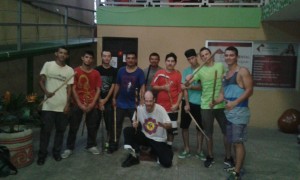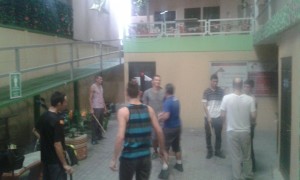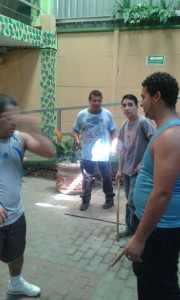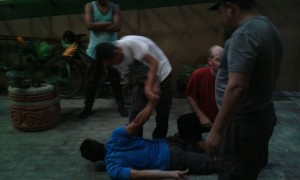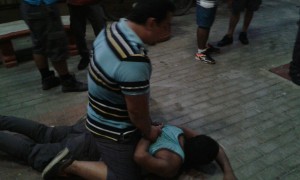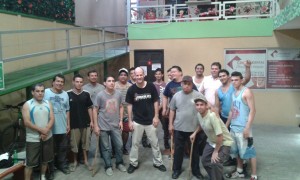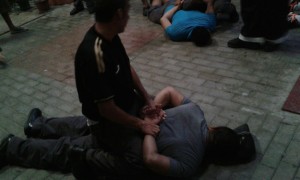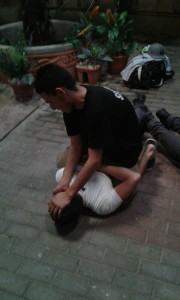This excerpt is taken from a body language program I had developed some time ago. As with all body language, it is circumstantial, contextual and person-specific. For any of you interested in a purely knowledge-based context, or for those whose lives may depend on profiling, reading or understanding other people’s aggression, I hope this helps in some way.
So much of our body language is through our original protection system developed evolutionarily. Adrenaline dump, fear, flight/fight/fright or freeze, protecting organs and vitals, mobility/respiration/vision flinch response that transfers to regular daily body language, so much of our history is from survival signals/instincts from thousands of years of highly-evolved development
Usually tells are derived from one of the three evolutionary fear responses:
FRIGHT/FREEZE (a neglected and sometimes utterly ignored element of the three, lip service is often only paid to the “fight or flight” axiom-temporary motion stop, visual/auditory/kinesthetic acuity (guilt, analysis of proper response/internal dialogue, emotion, surprise, shock), minimal bodily movement, momentary silence, making ourselves smaller, guilt responses, responses when placed back toward an open door/moving people/open window (increased respiration, heart rate, blood pressure and brainwave frequencies: Caveman reference with communal fire, tent, back to wall for protection from internal or external attack)
FLIGHT-shift feet toward exit, turn away from someone you don’t like, avoid conversations that threaten you, blocking behavior (closing the eyes, rubbing the eyes, placing hands in front of face, leaning away, placing objects on lap (purse) or in front of you, overall “distancing” (barriers, spatial creation, angling, body blading)
*exhibit caution as naturally visual people also lean back, create distance and have greater spatial “bubbles”
FIGHT-argument, insults, ad hominem phrases, counter-allegations, denigration of professional stature, defensiveness, goading, sarcasm; posture, eyes, puffing out chest, spatial violations, aggressive non-physical contact (ritual signs of violence, pacing, emphatic gestures, voice changes in tone), monotone response with minimal bodily gestures/motionless (James Bond/Jason Bourne examples)
Remember, to make a proper analysis non-verbal signs should be taken in clusters as one alone (although there are exceptions to the rule) is usually not sufficient to make a proper assessment of what’s happening internally with a person. Often this is a major mistake by those uncertain or a little too ambitious with their assessment. Since reading is done on the fly and some tells happen in a micro-second to assume is truly to make an ass out of –u and –me. Err on side of caution and if you can’t read properly and more evidence is needed, continue to develop rapport, be patient, keep them talking and ask specific leading questions. The type of question will obviously be different in regular conversation than it would be, for instance, during an interrogation. Connect certain reactions with parts of the conversation and topics that draw them out and ask connecting questions on the fly to determine a cause-effect.
Four intangibles for analysis:
- Different gestures mean different things (thus the multiple potential possibilities of so many individual gestures) in different contexts. The same tell can mean something totally different in a social setting vs. business meeting vs. home environment.
- This is why it’s so important to get multiples congruent signals to make a proper analysis. Very seldom does one gesture give enough of an explanation to make a firm deduction on its own.
- CULTURAL DIFFERENCES. What’s positive in one culture may be entirely offensive in another so factor this in and be aware of specific gestures to culture in question.
- Whether the gestures match each other and correlate for an overall picture or not. If differing or opposite signs come up ALWAYS believe the negative one as it’s far more telling and authentic. People can fake happy but don’t put a lot of practice into faking negative emotion, they come far more naturally
- Once again an evolutionary tool that’s been honed through centuries. The vaunted “feminine intuition” is prevalent in men as well but, being more logic-based and dismissive with metaphysical areas we tend to neglect development of this trait. Remember, one thing I always abide by: “if something feels wrong, it probably is.” Go with your gut, factor in your instinct along with your knowledge and “deciphering” capability. (Gavin de Becker’s “The Gift of Fear” as reference point for this)
Using the acronym, I call this “I4C or “I foresee” to remember the 1 I (intuition) and four C’s in the equation (clusters, culture, context and congruence)
One thing I always do if I’m somewhat uncertain about a certain nonverbal signal is to do it myself (tactfully of course so as not to mimic, an often clearly-perceived insult) and see how I feel or, more accurately, how it makes me feel.
It’s a proven fact that people tend to reveal far more clear and clustered body signals when comfortable than when stressed or tense. When we’re able to be relaxed and at ease we reveal much more than when we aren’t so the bad cop interview no longer holds water. The more at ease a person is and the more rapport we have with them the more important and imperative non-verbals can be detected. Rapport is also a strategy for just this reason. In this regard it is much easier to establish needed baseline behaviors, which cuts down the possibility of making critical errors in assessment. When a person is tense or threatened they tend to give off anxious, tense, nervous body language which can easily be mistaken for lying, aggression or anti-social.
CONTRADICTIONS
From our evolution and violent past, we often show remnants of body language that had direct purpose to survival but, as evolution always does, times have moved on and different survival systems have developed. These are, debatedly, somewhat scenario-specific:
- Ventral showing: showing lack of fear by showing organs and sending message of other being non-threatening to person showing. Often in modern violence this show of perceived arrogance and show of vulnerable parts of the body have proven dangerous against an underhanded modern criminal (especially one with a knife) Option? Blading the body. One can still show confidence and status with an open body posture slightly angled in discussion/confrontation
- Crotch display: showing confidence, machismo and competition to other men and sexual interest in a woman; one needs to be careful in a confrontation when opening legs too far apart and not paying attention to potential genital-related outcomes (including voice permanently etched with a higher pitch) Option? Once again, slight blading/angling of the body can still get the message across without being blindly confident and displaying a message of arrogance
- Neck show: to show vulnerability and submission, potential attraction from the opposite sex, see number one (contains lots of vital areas vulnerable to attack as well: Vagus nerve, carotid arteries, jugular veins, suprasternal notch as well as the superior and middle thyroid veins, sternocleidomastoid muscle) Option? Slight angling of the head away to keep the vitals partially shielded while still showing polite deference and interest
- Roots of the eyes: by looking down while maintaining eye contact is often perceived as submissive or negative in nature (though it can be perceived as judgmental as well), this is a very powerful confrontational tool that creates distance and sends a psychic message to one on the receiving end
- Walking pace: in the modern business world, a brisk pace indicates the desire to get things done, being on a mission and being energetic. When in public and constantly under scrutiny by other testosterone-filled men measuring, a slower but purposeful gait is a powerful show of calm and control (slowER methodical walk though the validity of having a strong gait and purposeful pace cannot be over-emphasized)
- Thumbs up: in the times of Roman gladiators, the crowd signified sparing or ending the life of the loser by either the thumbs-up or thumbs-down gestures
- Crossed arms: body protection, in times past it was an intentional sheltering of the body’s vitals including the lungs and heart
- Open palms: to show others that there were no hidden weapons being carried, a show of trust
- Nostril flaring: allows more air in with which to oxygenate the body in preparation for either fight or flight when threatened
- Hand shaking: originated from arm wrestling
- Territoriality: leaning on our possessions (or neutral possessions) to show ownership and protectiveness: cars, houses, chairs, etc.
- Hand gestures: karate chops, finger stabs & fist punches all signify reinforcement of message, the final word or emphasis of an important point, although as “communication is how the message is received, not given” these are all received relatively poorly by the one on the other end as they show dominance, aggression and argumentativeness
FROM THE ANIMALS
- Smiling: originally used by primates as a show of either fear or subordination to a more powerful member of the group; in modern it is similar in that it shows a non-threatening and accepting attitude towards the receiver (in carnivores it’s actually a threat)
- Chin jut: also from primates, showing aggressive intent for a forward and direct attack
- Baring teeth and flaring of nostrils: again, comes from the act of attacking
- Sneering: used as a signal to warn other animals of impending attack or defense if necessary
- Freezing/stillness: when a predator is in the animal’s area, somewhat of a “don’t pick me” signal
We have many similar signs from the animal kingdom that, when put in proper context and researched, have maintained their validity in the urban jungle to this day. We have a more than passing (and less than coincidental) interest in animal movement, attack strategies and predatory methods and this, in an opinion, is far more valuable than looking back in history at our own past and methods/tactics. Theirs have stood the test of time without change.
One element of learning I try is when one of the family dogs is present, I go through various human body language signs and facial expressions to gauge response and even our friendly K-9s often react in predictable ways towards clear negative and positive projections.
Though not body language, per se, other examples of our survival instinct past and evolution that has manifested itself in modern-day scenarios:
- Sitting with your back to the door/open window creates increased blood pressure, heart rate, respiration and brainwave frequencies back from the Caveman days with the communal fire, multiple people eating in the tent after a kill, sitting with their backs to the wall for protection from both internal and external attack
- King Arthur’s round table: designed to create neutrality in meetings but not realizing that his own high-status created a pecking order of importance from those seated next to him (higher power) to those further away (lower power) to those seated diametrically-opposed (competitive)
- The term “right-hand man” coming from the fact that the one sitting directly to the leader’s right was the least threat due to the fact it was difficult to stab effectively with your left hand, considering in those days left-handed had a negative stigma attached to them and the staunch majority were right-handed
- The handshake. Originated from a grasping of the mid-to-lower arm to ensure there were no hidden weapons that could be pulled at a future point in the interaction
- 2nd arm during a handshake. Seemingly-kind, at times can be a hidden attempt to control through touch, establish dominance in a subtle and potentially hidden way
- Sitting across from each other at a table. Originally coined the “gunslinger” position due to the fact that squaring off the torso of the body was a sign of competitiveness. (although context-dependent in the modern-day)
- After eating, stomach takes blood away from the brain to help digestion (similar to fight-or-flight adrenaline response) and causing the person to not think as clearly. Bad for business decisions, good for romance, extremely good to take advantage of a vulnerable opponent with shady dealings
- Frontal display, showing confidence by exhibiting glibly one’s organs to show that they don’t find you threatening in any way, has come back to haunt some as they’ve transferred business tactics into the street world, where violence is a threat and this display is highly-unprotected
***Contagious actions that can give psychological openings pre-conflict: yawning, nervousness, confusion.

